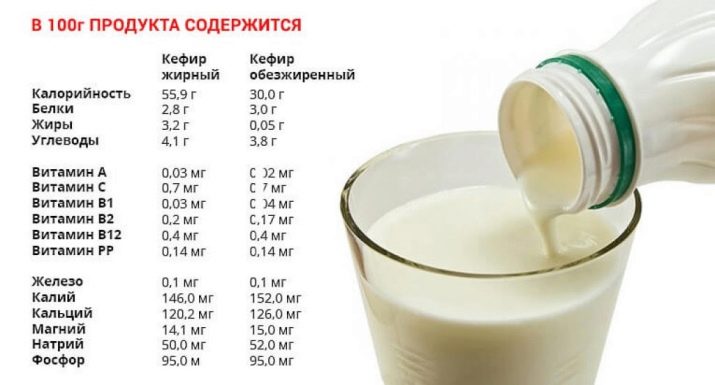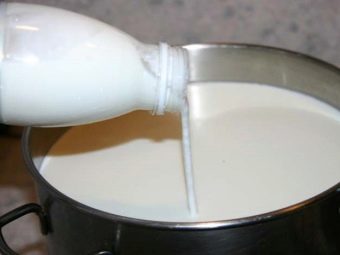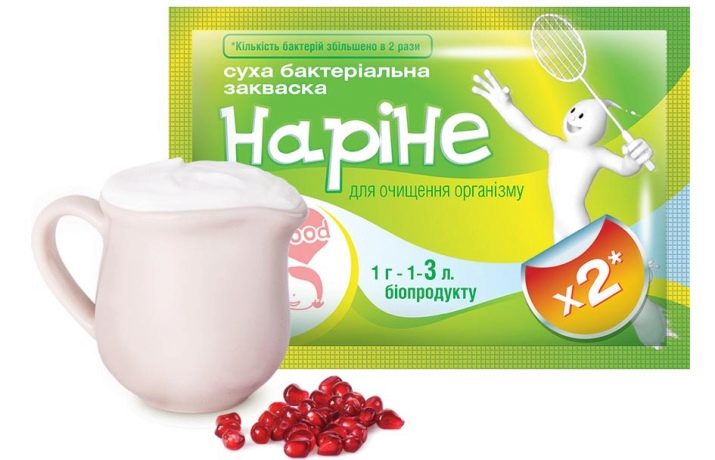Children's kefir: benefits and harm, recommendations of the reception, recipes

For the full growth of the child need regular intake of nutrients.At first, everything you need is contained in breast milk. With the passage of time, the baby begins to receive complementary foods, tries various “adult” products. The diet is gradually expanding, and among other dishes, kefir gets into the menu.
What is useful?
Kefir is a fermented milk product based on regular cow's milk. It is produced by fermentation using special starter fungi. It is believed that the birthplace of the drink - the Caucasus.
Kefir is rich in nutrients necessary for the full development of the child's body. You can list the main elements:
- vitamins (D, C, B, A, E and others);
- proteins (albumin, casein);
- trace elements (phosphorus, magnesium, calcium, and so on);
- beneficial microorganisms contained in the fungal yeast (22 pieces).
At one time, researchers were seriously engaged in the study of kefir and revealed many useful properties. Thanks to sour-milk bacteria, the drink has a positive effect on the digestive system and generally improves human well-being. Many characteristics of kefir are good not only for adults, but also for children:
- fermented milk drink helps in the formation of the intestinal microflora of the baby;
- It promotes better absorption of vitamin D and iron in the body crumbs;
- kefir plays the role of an antiseptic in gastrointestinal infections, fighting with their pathogens;
- kefir protein has a beneficial effect on the development of the muscular frame of the child;
- special sour-milk bacteria are involved in the work of the baby's liver, removing part of the load from it;
- Kefir contains a lot of calcium, which is necessary for the formation of teeth and strong bone tissue;
- against the background of the use of this drink, there is a general strengthening of immunity and improvement of children's appetite.
Possible harm
Glut by any product does not benefit the child’s body. Excess consumption of kefir can sometimes lead to trouble.
- Individual intolerance to kefir fats is possible.
- As part of a sour-milk drink, casein is present (a complex milk protein) that can provoke an allergy. About 10% of children suffer from food allergies. Its manifestations become noticeable in a few hours after eating food containing the allergen. Signs of an acute allergic reaction can be nausea and vomiting, fever, severe abdominal pain. If the nature of the allergy is non-aggressive, the appearance of a rash and redness of the mucous membranes is possible. Any of these symptoms is a reason to consult a doctor for qualified medical assistance.
- The kid's stomach is at risk not to cope with kefiric acids. The result of this “flaw” may be the appearance of liquid stool or, conversely, constipation.
- The kidneys are able to react negatively to the minerals and proteins contained in the composition of the drink.
- You should not give kefir to children who are rapidly overgrown with a “soft crown” (front spring). This threatens to glut calcium, which in the body crumbs and so, apparently, in excess.
- According to some pediatricians, it is not recommended to pamper children with yogurt up to a year. Experts explain this by saying that it is difficult for the infant's stomach to process lactose to the end. As a result - skin rashes, itching and unpleasant peeling.
When can I give?
The introduction of kefir in the diet of the child should be carried out slowly. Babies who are breastfed are given a fermented milk drink from the 8th month of life (if the baby’s weight is within the normal range or slightly higher). Artificialists - a month earlier. By this time, the child had already “met” some vegetables (zucchini, broccoli, cauliflower, pumpkin) and cereals without milk and salt. Therefore, its digestive system is considered to be prepared for taking and processing kefir.
Some parents tend to introduce kefir into the diet of their offspring almost from birth. For a newborn, it is very dangerous, since such haste leads to the leaching of iron from the body.
With large consumption volumes, gastric microbleeds are generally possible.
In any case, acquaintance of the baby with a new product is not a field for parental initiative. Before introducing kefir into the diet, it is necessary to consult with the district pediatrician and follow his recommendations and advice exactly. The well-known children's doctor Komarovsky advises introducing cottage cheese into the baby food, as well as toddlers of any age, for example, at 4 or 11 months, which is properly prepared at home. This product has only positive feedback.
For more on this, see the following video.
How to choose and use?
The range of children's kefirs today is quite wide. On the shelves of stores you can find such brands as “Tyoma”, “Agusha”, “Fruto-Nanny”, “Our Masha”. The difference between similar products from different manufacturers is mainly in price. Taste characteristics and composition do not have a significant difference.
When buying, you need to pay attention to several important factors.
- Age marking (7+, 8+, and so on), where the number indicates the month from which you can start feeding specifically with this type of kefir.
- Production date and shelf life (the shorter the storage time, the better).
- Permissible fat content should correspond to 3%.
- In any case, it is desirable to make sure that the list with the composition is not the notorious note "E".
- Dairy products should be stored on special refrigerated display cases or on shelves that are protected from direct sunlight and are located at the maximum allowable distance from the central heating system batteries. If these simple rules are not followed, then it is better to look for baby kefir in another, more responsible grocery store.
- Be sure to assess the integrity of the package, check it for scratches and other damage. Violation of tightness and air access will significantly impair kefir properties or completely spoil the product.
Kefir, made especially for children, differs from the “adult” drink with the same name (take at least the fact that its production is characterized by a higher temperature). Ingredients included in the composition (yeast, milk), only the highest grade. There are no food additives and all sorts of dyes, no starch. The taste of baby kefir is not so sour, rather even soft and tender.
In general, all fermented milk products for babies are low-fat, have low acidity and are easier to digest by the child's stomach. Additionally, they are enriched with vitamins.
At the manufacturers of baby food is carried out strict supervision over the quality of products, equipped with separate technical lines.
There are several types of kefir for children:
- simple kefir contains a number of dairy fungi that are beneficial to the intestines of the baby;
- Bifidokofiry and biokefiry enriched with bifidobacteria and promote calm digestion, this type of fermented milk product is more popular among pediatricians and parents than the first option.
The volume of kefir when you first meet him should be about 30 ml (2-3 teaspoons). It is advisable to feed them a child in the morning and observe during the day whether the product has digested.
Then, continuing to pay close attention to the health of the baby, you can increase the portion:
- in the first week, the volume of the consumed product is brought to 100 ml and remains at this point until the child reaches the year;
- up to 2 years - a maximum of 200 ml at night;
- up to 3 years - 400 ml per day;
- over 3 years old - a daily rate of 1 l, from this age you can try to introduce kefir intended for adults.
Nutritionists recommend drinking a fermented milk drink shortly before a night's sleep. In this case, the child will be fed, but not pereadet. The stomach will begin to work in a quiet mode and will provide deep healthy sleep.
Daily use of kefir is not forbidden, but in order not to overdo it, the optimal rate is recommended - 3 times a week. The child can drink with a spoon. If the baby is used to getting liquid from the cup, it will be even easier.
It happens that for some reason known only to him the baby does not want to drink kefir. In this situation, you should either temporarily stop the fermented milk feed, or go to the trick - a little sweeten the drink. Sugar is better not to use, as it reduces the nutritional properties of the product, causes intestinal fermentation and flatulence (often with pain syndromes). But some kind of fruit (banana, for example) is fine. Another possible option is to offer your favorite cookies in addition to kefir.
There are some more simple tips on the use and storage of kefir.
- The ideal temperature for a baby’s drink is room temperature.
- Unopened pack of kefir should be stored only in the refrigerator.
- An open and not fully used product to store, and even more so to offer the child the next day, is strictly prohibited. This is fraught with extremely negative consequences for the fragile children's body.
- It is not necessary to dwell on one type of kefir. It is possible and necessary to try different options, since they differ in the content of prebiotic bacteria, which bring only benefit.
How to do?
If you do not want to treat the crumbs with the purchased product, then you can prepare the drink at home yourself (it is more convenient to cook in the evening). Quality kefir is obtained from special starter cultures, and ideally it is better to use milk homemade.
For cooking homemade kefir, there are different recipes.
Classic recipe
Ingredients: 0.5 liters of milk, a quarter of a liter of water (if home-made milk is used), 30 g of sour cream or biokefir.
Cooking method: homemade milk with water is subjected to a five-minute boil (milk from the store just boil and then cool to about 40 degrees). After a little cool liquid, add biokofir or sour cream. Mixing all the ingredients, it is necessary to let the mixture brew in the heat for at least 9 hours. After this time, the product is ready to use.
Over the next 2 days, the remaining liquid can be put on the leaven.
Using dry yeast
Ingredients: One type of dry starter culture (for example, “Narine”), 0.5 liters of milk, 0.5 liters of water (for home-made milk).
Cooking method: you need to bring the liquid to a boil, cool and add the leaven (half a bag for purchased milk, a whole bag for home). The ingredients are thoroughly mixed and sent to "reach" in a warm place.
Among the remaining recipes are the following.
other methods
- It will be required: the volume of water and milk from the previous recipe, baby kefir drink in a volume of 10 ml. The cooking algorithm is the same as in previous versions.
- Looking for: a glass of fresh milk, a tablespoon of kefir (maximum fat content of 2.5%). Cool the milk after boiling and add kefir there. Keep the mixture at room temperature for half a day and leave in the fridge overnight to complete the process.
- Take: 1.5 cups of kefir, a liter of milk. Remove the milk from the stove at the first sign of boiling, cool to a warm state, add kefir, mix and pour the mixture into a glass container. At the time of infusion (12 hours) instead of the lid, tie the neck with several gauze layers.
Cooking homemade sourdough
Heat milk a little, add one portion of “Narine”, mix well, pour into a thermos and leave for 12 hours. After infusion, the mixture is sent to the refrigerator for another couple of hours.
Sourdough in the amount of 2 tablespoons can be added to preheated milk, mix and pour into a thermos bottle for 6-7 hours. Result: ready-made fresh kefir on homemade sourdough.
So, as you can see, kefir is a healthy and tasty product.Its value in the children's diet is obvious. However, it is important to remember that kefir should not become the main drink for the child. At this tender age, he is generally regarded more as food, and not as a drink to quench thirst.
To consume, but not abuse, the use of the product is the golden rule for sensible parents. After all, everyone wants their children to grow up healthy and happy.



































